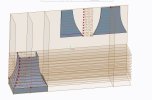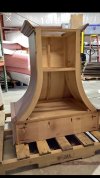I started my shop around 2003, probably purchased all my machinery by 2005. Smaller hand and power tools seem to be an ongoing purchase though.
I get by just fine, it is certainly not a mass production shop, but can do anything I need, just lengthy set up times due to the difference from one custom job to the next. I get by just fine without CNC, again we build mostly one off stuff, being things we can't buy in the market.
The biggest challenge so far was building a curved range hood, not laminated, out of 3/4 ply. CNC would have been a great help to mill those curves perfectlly, but I could not find anyone who have figured out the math to do the second set of curves. The production shops making those seem to preserve that as a top secret, they won't share. One guy mentioned they cut and bend the sides first, then use the CNC to scribe the bent curve and capture in the software. Sounded really complicated.
So in short, everything I have has been fully depreciated, around 20 years old. There has been little to no maintenance, but everything still works just fine.
Am I perhaps missing something?
I get by just fine, it is certainly not a mass production shop, but can do anything I need, just lengthy set up times due to the difference from one custom job to the next. I get by just fine without CNC, again we build mostly one off stuff, being things we can't buy in the market.
The biggest challenge so far was building a curved range hood, not laminated, out of 3/4 ply. CNC would have been a great help to mill those curves perfectlly, but I could not find anyone who have figured out the math to do the second set of curves. The production shops making those seem to preserve that as a top secret, they won't share. One guy mentioned they cut and bend the sides first, then use the CNC to scribe the bent curve and capture in the software. Sounded really complicated.
So in short, everything I have has been fully depreciated, around 20 years old. There has been little to no maintenance, but everything still works just fine.
Am I perhaps missing something?


